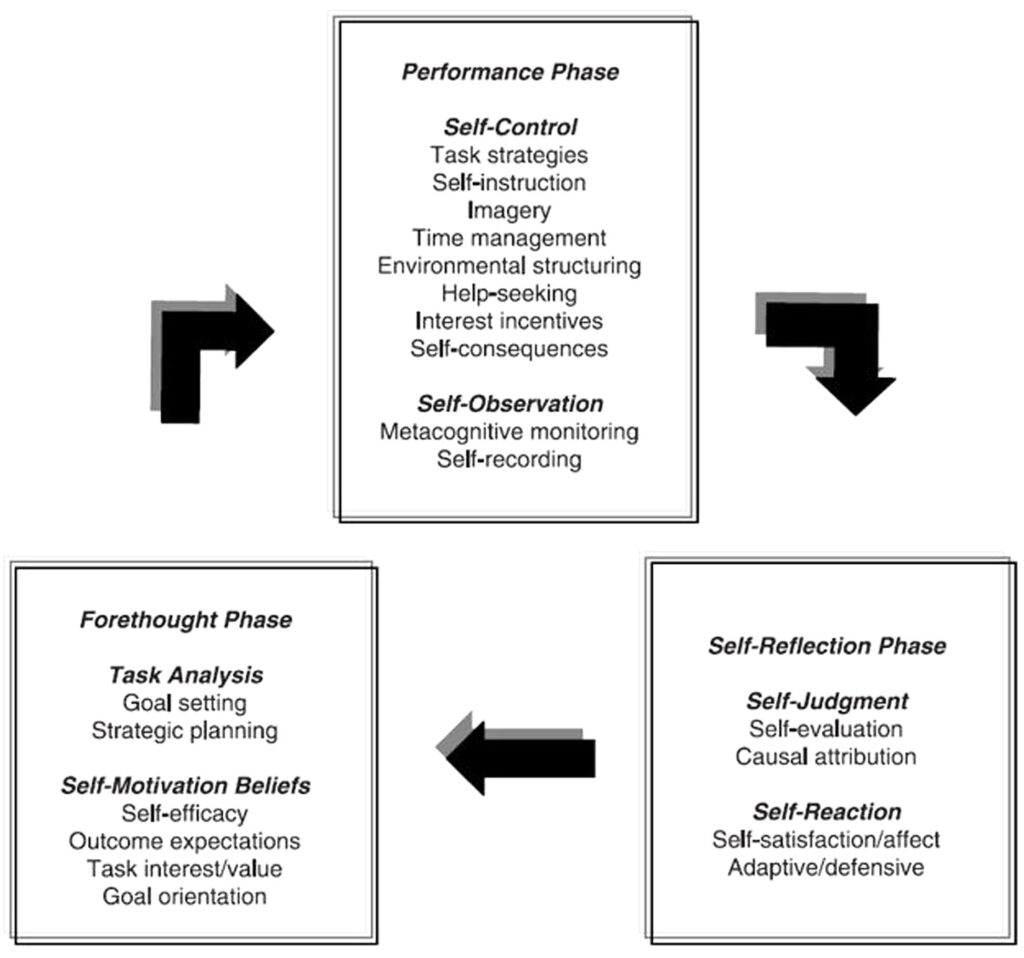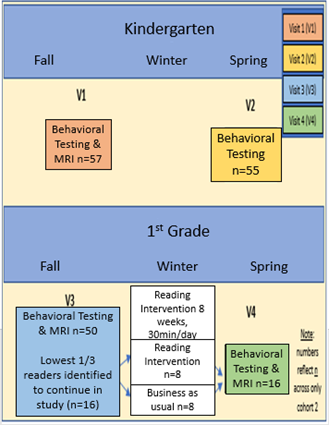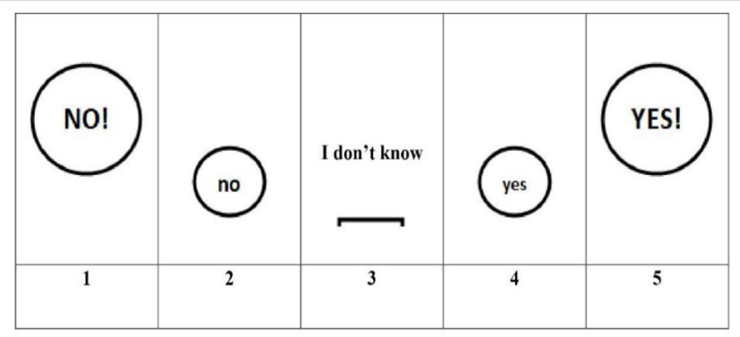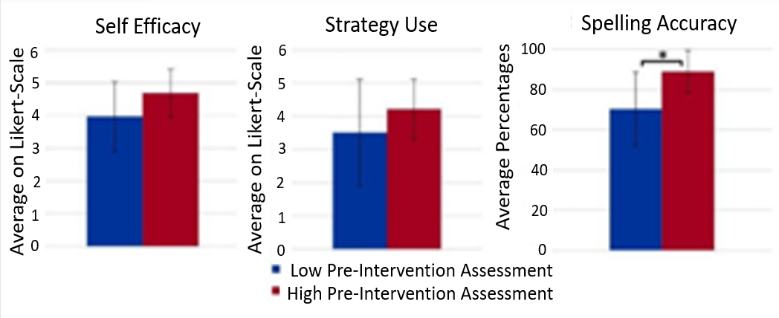Self-regulated Learning and Spelling: A Pilot Study of First Graders
ABSTRACT
This exploratory study assesses self-regulated learning (SRL) of first graders during reading and spelling tutoring. Approximately 40% of students nationally are struggling readers, and the realm of spelling provides insight into the cognitive processes of students learning to read. SRL is the process by which learners actively work towards a goal through self-directed forethought, performance, and self-reflection. For this study, the SRL components of focus were self-efficacy and metacognition of strategy use. The level of confidence in oneself to perform well on a task is known as self-efficacy. It is unclear whether emphasizing SRL techniques is beneficial for students early in education because cognitive abilities required for SRL are still developing. Eight first graders received 40 sessions of 30-minute 1:1 reading and spelling tutoring sessions from trained research assistants over the course of eight weeks. Participants’ spelling skills were assessed each week. In addition, participants completed an SRL questionnaire about strategy use and self-efficacy using a Likert-scale format. The relationships between questionnaire responses on self-efficacy, strategy use, and spelling accuracy were determined. There were positive correlations between strategy use and self-efficacy, strategy use and spelling accuracy, and self-efficacy and spelling accuracy. These findings indicate that first graders’ reported self-efficacy is a predictor of their performance as metacognition develops, suggesting that emphasizing SRL techniques early in education may benefit students’ performance in school.
INTRODUCTION.
Even with extensive research surrounding reading education, young students still struggle with reading at large. A 2005 study of fourth-graders representative of the United States fourth-grader population revealed that approximately 40% of students are “nonfluent” readers nationally [1]. Literacy learning in the classroom encompasses many of the vital skills for a successful adulthood, such as refined writing and reading comprehension [2]. By the early grades of elementary school, students are grouped by their reading and spelling skills, with the advanced learners often funneled into accelerated programs while others fall behind. Over the course of reading instruction, struggling readers are easily trapped in a negative feedback loop of discouragement in the classroom, leading to a lack of motivation. They frequently avoid reading, which widens the gap between struggling students and advanced readers further [2].
Although reading research is abundant, the literature has historically overlooked spelling education, perhaps due to its relatively smaller window of instruction mostly contained in primary education (kindergarten through fifth grade) [2]. Spelling research can reveal much about the way young students learn to read. This is because a primary skill of reading is decoding or understanding the relationship between graphemes (letters) and phonemes (sounds). This proposes that a mastery of spelling also correlates with a mastery of reading within the assessed domain [4]. These basics of decoding learned and practiced through spelling instruction have been shown to be the backbone of all further reading skills [3].
Across content areas, educators have long seen the value of self-regulated learning (SRL) and America has placed emphasis on strengthening such learning techniques for older students (students past primary education) in recent years. Self-regulated learning is defined as the process by which learners of all ages actively work towards a goal through self-directed forethought, performance, and self-reflection (Figure 1). Forethought could be devising a personalized planned use of learning strategies to achieve the domain-specific goal. Performance could be management of time and elimination of distractions, in order to efficiently learn through self-instruction. Self-reflection could be the internal assessment of how the actions taken to achieve the goal related to the performance of the task [5]. This model portrays SRL as a cycle of phases in relationship to the task, with each phase supporting and leading into the next.

SRL use is a predictor of learning outcomes, meaning those who use SRL the most are likely to be high academic achievers based on past literature [5]. Higher self-efficacy is linked with higher cognitive strategy use, affecting the rate at which students retain information and learn. Low self-efficacy is a predictor of low academic performance in older students and vice versa [5].
There is also support that SRL leads to improved performance in the domain of reading [7], and elements of SRL related to motivation and confidence play a key role in learning to read and spell [8]. Past research claims that three out of four first graders believe that their spelling is good, but this number dropped to less than half of students once they were in third grade. This suggests that self-efficacy decreases throughout primary education. Helping students remain confident in their academic abilities contributes to their motivation to continue practice [9]. Supporting SRL early on could help target this self-efficacy decrease before it occurs later on in their education [2].
Due to the demanding nature of SRL, there has been little research of SRL and primary grade students. Students at this age are still developing the skills required for SRL. It is unclear whether these developments can be applied in the direction of SRL in first grade, or if relationships between young children and SRL are simply not present [5]. Generally, it is known that self-efficacy is distinguishable between tasks for younger students, but further investigation is necessary to distinguish whether these relationships of SRL known in older students remain true for younger students [8].
A study of SRL in early elementary aged students could help to identify if SRL skills are present in younger students and determine if first grade could be a beneficial time in education to support and practice SRL skills. It is commonly known that implementing a practice at a young age tends to turn this practice into a second nature for the individual. For this reason, a life skill like SRL should not be overlooked in primary school instruction [7].
This study aims to answer whether there is a correlation between first graders’ self-efficacy and strategy use, strategy use and spelling accuracy, and spelling accuracy and self-efficacy. We hypothesize that due to the preexisting relationships in older children, a pattern of direct relationships between all three variables in first graders. It is expected that higher spelling accuracy will be related to higher self-efficacy and strategy use metacognition, indicating that first graders generally have the fundamentals to begin SRL.
MATERIALS AND METHODS.
Eight first graders (mean age=6.51 years; 88% female) from an urban school district in Nashville, TN and surrounding areas participated in the intervention stage of this study. These participants were a subset of a larger sample of participants (N= 50) in a 2-year study investigating the relationship between executive function and reading development in kindergarten and first grade students (Figure 2). Once all participants completed the Test of Word Reading Efficiency [10] and the Woodcock-Johnson-IV [11], the lowest-scoring third of readers were assigned to continue the study (n=16). These participants were then randomly assigned to the reading intervention group (n=8) or the waitlist control group (n=8). Participants were compensated with $100 online gift cards for tutoring and with additional gift cards for behavioral testing. This human research and associated procedures were approved by the Vanderbilt Internal Review Board; consent was obtained prior to participation and all data were deidentified.

Intervention.
The Word Identification and Spelling Test [12] Sound Symbol Knowledge subtest was used to assign participants’ starting level of the program. Participants received 40 sessions of 30-minute one on one reading and spelling tutoring from trained research assistants. This model of tutoring allowed for individualized pacing where necessary. While some participants had one tutor through their eight weeks, others had two different tutors throughout the study due to scheduling.
The University of Florida Literacy Intervention (UFLI) Foundations program was the reading and spelling intervention. After two lessons (approx. every fifth session), participants completed a spelling assessment covering the most recent two lessons taught to assess the student’s reading and spelling progress and guide the tutors’ future instruction.
Self-Regulated Learning Measures.
The researcher-generated questions for the interview and weekly questionnaire were based on elements of the Early Literacy Motivation Survey [8], Reading Self-Concept Scale [13], Motivation for Reading Questionnaire [14], and Motivated Strategies for Learning Questionnaire [15]. Due to the distinctive age of participants and time constraints within the intervention for administering a questionnaire each week, no single measure in the literature met the study’s needs. Chapman and Tunmer suggest that the ability to detect SRL in young elementary-school aged children depends upon the measurement instrument’s inclusion of domain-specific language [13]. Self-efficacy is also distinctively characterized by domain-specific self-assessment [5]. More general language about self-regulation could be more difficult for young children to connect to their current learning. Developing questions for the measurement instrument that were specific to the content (spelling and spelling strategies) and context (tutoring and weekly spelling assessments) was the objective.
Self-regulated learning interview. Pre and post eight-week intervention, participants were asked the following open-ended questions for broader exploration of SRL beyond self-efficacy.
- How do you feel about spelling?
- What do you do when you have to spell a word?
- Do you think tutoring is going to help/helped you become a better speller? How?
Students had the freedom to verbally respond with as much feedback as they preferred. The responses were put in writing by the tutor, and there was no tutor follow-up questioning.
Self-regulated learning questionnaire. Each week, participants were given a series of researcher-developed statements about their SRL relating to the spelling assessment they were completing that session. Cleary et al. (2012) suggested an assessment technique known as SRL microanalysis. The statements below were used specifically to micro-analyze SRL processes in relation to an active task.
- I have the strategies to do a good job on my spelling activity.
- I am feeling positive about today’s spelling activity.
- I used strategies on the spelling activity today.
- My work this week in tutoring helped me on the spelling today.
- Tutor Assessment: I saw or heard the student use strategies on today’s spelling assessment.
Statements 1 and 2 of the questionnaire were administered prior to the assessment, and statements 3 and 4 were administered after the assessment, reflecting the forethought and self-reflection phases of Zimmerman’s model [16]. The 5th statement was a tutor assessment done after student completion of the questionnaire. Each statement represented an element of SRL. The scope of this study was limited to responses from statements 1 and 3 only, in order to focus on the strong relationship between self-efficacy and metacognition shown in current literature. The first statement, “I have the strategies to do a good job on my spelling activity,” targeted the participant’s self-efficacy; the third statement, “I used strategies on the spelling activity today,” targeted the participant’s metacognition of strategy use. Students expressed their level of agreement or disagreement with the statements read by the tutor by using an adapted 5-point Likert scale (Figure 3) and pointing to their response.

Analysis.
Correlations were conducted to detect relationships between spelling accuracy, self-efficacy, and metacognition of strategy use for each of the eight time points. Due to the non-normally distributed categorical data, a Spearman correlation was used.
Post-data collection, the eight participants’ data were divided into the four highest pre-test scoring participants and the four lowest pre-test scoring participants to further explore the relationship between academic achievement and SRL. The post-hoc analysis aimed to investigate the research question: Do first graders with previously higher reading achievement have higher average self-efficacy, strategy use, and spelling accuracy than those with previously lower achievement? Word Identification and Spelling Test (WIST) was the pre-tutoring test used to place participants into appropriate tutoring lessons. Mann-Whitney U Tests were run across both groups for all three measures to analyze any significant differences between the two groups.
Due to the small sample size, missing data across SRL questionnaire items two, four, and five required removing those statements in the SRL questionnaire from the study research questions and analyses entirely.
RESULTS.
Spearman correlations were calculated between each pair of variables (self-efficacy and spelling accuracy, self-efficacy and strategy use, and strategy use and spelling accuracy) for each of the eight weeks of the intervention (Table 1). The correlations were inconsistent in magnitude across weeks, but were generally positive, which aligned with the researchers’ hypothesis. Self-efficacy and strategy were significantly correlated on week eight. No other correlations between any variables were significant.
| Table 1. Spearman Correlations for Eight Weeks. Spearman correlations between self-efficacy, strategy use, and spelling accuracy for eight weeks. Significant correlations are bolded (p<0.05). | |||
| SE & Accuracy | SE & Strategy | Strat. & Acc. | |
| Week 1 | 0.10 | 0.34 | 0.84 |
| Week 2 | 0.52 | 0.69 | 0.36 |
| Week 3 | -0.25 | 0.66 | 0.10 |
| Week 4 | 0.50 | 0.66 | 0.60 |
| Week 5 | 0.16 | 0.27 | -0.04 |
| Week 6 | 0.67 | 0.38 | 0.16 |
| Week 7 | 0.59 | -0.01 | 0.08 |
| Week 8 | 0.66 | 1.00 | 0.66 |
In the exploratory post-hoc analysis, participants with higher pre-intervention assessment scores (n=4) were compared with participants with lower pre-intervention assessment scores (n=4). The groups’ mean self-efficacy ratings, strategy use ratings, and spelling accuracies were compared (Figure 4). Spelling accuracy averaged significantly higher for the high pre-intervention assessment group (p=0.03), meaning that participants who scored higher on an assessment prior to intervention were significantly more accurate on their spelling assessments compared to participants who scored lower prior to intervention. Mean ratings for self-efficacy and strategy use were higher for the high pre-intervention assessment group (p>0.05), meaning that these participants reported higher self-efficacy related to their spelling skills and use of strategies on their spelling assessments.

DISCUSSION.
This study was conducted in order to gain insight into first graders’ SRL abilities related to spelling to begin bridging the gap in the literature for this age group. Specifically, the study investigated the relationship of self-efficacy, strategy metacognition, and spelling accuracy of first grade students within a reading and spelling intervention. Due to past findings with older children, positive correlations for each of the three comparisons were hypothesized.
The large majority of correlations were positive, yet only the one relation between self-efficacy and strategy was significantly correlated. The three negative R-values are somewhat outlying from the respective correlation groups, since there was one negative relationship observed in each of the three comparisons. This shows that first-graders are likely able to use a Likert-scale to reflect on SRL, even though metacognition is developing. Strong correlations were not hypothesized for this reason; however, the results did confirm the expected pattern of positive correlations. By detecting common SRL patterns within this age group, there is reason to further explore the extent of these relationships in the future.
To further investigate the inconsistencies in the correlations and determine if incoming reading and spelling skills were a possible factor, a post-hoc analysis was performed between the higher scoring half and lower scoring half of participants on their pre-intervention assessment (WIST). Though inconsistent, the lower scoring pre-intervention assessment participants generally responded lower on both self-efficacy and strategy use Likert-scales and performed lower on the spelling assessments. This pattern would be expected because there is a positive correlation between the three measures. This finding provides further support that students this age are able to use SRL and report it.
This pilot study was impacted by some limitations such as sample size, missing data and non-standardized measures. It is also impossible to conclude that increased academic achievement is purely due to SRL skills; environmental factors likely contributed to changes in academic achievement as well. In the future, comparing participant reported strategy use with tutor’s report of observed strategy use could reveal the accuracy of participant self-reports. It should also be noted that the one on one, individually paced tutoring environment would likely lead to a higher self-efficacy than self-efficacy in the general classroom.
Future studies should investigate the relationship between self-efficacy, strategy metacognition, and accuracy related to reading and spelling in first grade students to further conclude to what extent SRL skills are present and support learning in this age group. Additionally, future studies should include measures of student SRL behavior such as teacher-reported use of strategies to provide additional confirmation of the student-reported strategy use and self-reflections.
The results of this pilot study indicate that self-efficacy and strategy metacognition are two elements present in struggling first grade students, based on the patterns from this sample of eight first graders. Due to the relationship between SRL and spelling performance within this sample, future research should include younger students when considering the possibility of SRL interventions. Primary schoolers could have the opportunity to assess what strategies are efficient and motivational for themselves early in their education. Higher academic achievement would be the expected outcome. Younger students may have boosted confidence in themselves. This stage of high self-efficacy could be taken advantage of by establishing the practice of self-assessing self-efficacy in relationship to tasks through SRL instruction. Offering the tools and implementing the practices of SRL in the classroom in the early years of education would hopefully lead to greater use outside of the classroom, which may facilitate learners to reach greater self-regulation.
ACKNOWLEDGMENTS.
Thank you to the School for Science and Math at Vanderbilt and the Education and Brain Sciences Research Lab. This research was made possible by the following funding sources: R37 HD095519 MERIT Award and P50HD103537– Vanderbilt Kennedy Center for Research on Human Development.
REFERENCES
[1] M. C. Daane, J. R. Campbell, W. S. Grigg, M. J. Goodman, and A. Oranje, The Nation’s Report Card: Fourth-Grade Students Reading Aloud: NAEP 2002 Special Study of Oral Reading.
[2] J. L. Rankin, R. H. Bruning, and V. L. Timme, The development of beliefs about spelling and their relationship to spelling performance. Appl. Cogn. Psychol. 8, 213–232 (1994).
[3] W. A. Hoover and P. B. Gough, The simple view of reading, Read. Writ. 2, 127–160 (1990).
[4] N. J. Conrad, From reading to spelling and spelling to reading: Transfer goes both ways, J. Educ. Psychol. 100, 869–878 (2008).
[5] B. J. Zimmerman, Self-Regulated Learning and Academic Achievement: An Overview, Educ. Psychol. 25, 3–17 (1990).
[6] E. Panadero, A Review of Self-regulated Learning: Six Models and Four Directions for Research, Front. Psychol. 8, 3-19 (2017).
[7] S. Graham and K. R. Harris, The Role of Self-Regulation and Transcription Skills in Writing and Writing Development, Educ. Psychol. 35, 3–12 (2000).
[9] J. Downing, J. DeStefano, G. Rich, and A. Bell, Children’s Views of Spelling, Elem. Sch. J. 85, 185–198 (1984).
[10] J. K. Torgesen, TOWRE, Test of Word Reading Efficiency: examiner’s manual / Joseph K. Torgesen, Richard K. Wagner, Carol A. Rashotte. Austin, Tex: PRO-ED (1999).
[11] F. A. Schrank and B. J. Wendling, The Woodcock–Johnson IV: Tests of cognitive abilities, tests of oral language, tests of achievement, in Contemporary intellectual assessment: Theories, tests, and issues, 4th ed, (New York, NY, US: The Guilford Press, 2018), pp. 383–451.
[12] B. A. Wilson and R. H. Felton, Word identification and spelling test, Interv. Sch. Clin. 40, 194- (2005).
[13] J. W. Chapman and W. E. Tunmer, Development of young children’s reading self-concepts: An examination of emerging subcomponents and their relationship with reading achievement, J. Educ. Psychol. 87, 154–167 (1995).
[14] A. Wigfield and J. T. Guthrie, Relations of children’s motivation for reading to the amount and breadth or their reading, J. Educ. Psychol. 89, 420–432 (1997).
[15] Reliability and Predictive Validity of the Motivated Strategies for Learning Questionnaire (Mslq) – Paul R. Pintrich, David A. F. Smith, Teresa Garcia, Wilbert J. Mckeachie (1993).
[16] D. J. Hacker, J. Dunlosky, and A. C. Graesser, Handbook of Metacognition in Education (Routledge, 2009).
Posted by buchanle on Tuesday, April 30, 2024 in May 2024.
Tags: metacognition, Self-efficacy, Self-regulated learning

